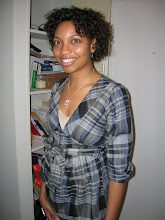I read in the Times yesterday and found that Naomi Sims, a black supermodel,(Not to be confused with Naomi Campbell!) notably recognized for breaking the chains off of the American modeling circuit recently died from cancer. I think there is something very profound about her story, as before her most of the black models were lighter-skinned. One very disturbing part of her journey as a model is that she was rejected often early in her career because she was "darker-skinned" and that her "look" would be rejected by readers. I find this interesting, because it seems the ideas of beauty for black women have been originated by the European idea of beauty. I started to research the stories of major black super models such as Naomi Campbell, who graced the cover of the Vogue Paris due to an advertiser refusing to advertise if she wasn't chosen.
Now looking at some of the newer generation of models it is interesting to see that how certain shades of black women become prominent at different points in our history. To my knowledge Naomi Sims came on during the "Black is beautiful" movement, and now looking at some of the current models such as Chanel Iman and Selita Ebanks are fairly lighter. There is a very caramel look happening now that seems to act as a happy medium between light and dark. Again, fashion and trends are changing all the time, where old ideas are recycled and reused in different ways.It seems that ideas on black beauty are too.




